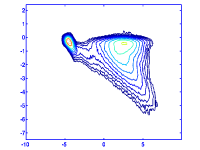Multiple Quantum MAS
Multiple quantum magic angle spinning (mqmas) is a two-dimensional solid state nmr technique that correlates the (m,-m) coherence with observable single quantum coherence of quadrupolar nuclei in such a way as to achieve high resolution of chemical shifts, free from both first and second order quadrupole broadening. To see how mqmas works, one must understand the notion of phase coherent states of a statistical ensemble of spins. The wave function for a typical member of spin ensemble is, in general, a linear combination of all the possible basis functions:
![]()
The spins are said to be in a state of coherent superposition if one or more cross products, c1(t)c2(t)*, is different from zero when averaged over the ensemble. When the ensemble of spins experiences a strong, uniform, static magnetic field, each coherence oscillates harmonically in time at a "beat" frequency equal to the difference in corresponding eigenvalues of the Zeeman Hamiltonian. Coherences between states that differ by ±1 in magnetic quantum number m are called single quantum coherences; they give rise to precessing transverse magnetization and hence to observable nmr signal. By analogy, higher order coherences between states that differ by more than one unit of angular momentum are called multiple quantum coherences. They produce no magnetization, and can not be observed directly.
Frydman and coworkers (J. Am. Chem. Soc. 117, 5367, (1995)) first realized that the precession frequencies associated with symmetric (-m,m) multiple quantum coherences offer a unique opportunity to achieve a spectacular gain in spectral resolution. Under conditions of fast magic angle spinning, the precession frequency is given by a sum of three terms:
![]()
The first term is the ordinary chemical shift, amplified by m, the order of the multiple quantum coherence. The second term is called the isotropic second order quadrupole shift, it arises from the fact that when truncated at second order by a strong Zeeeman interaction, the trace of the quadrupole Hamiltonina is not zero. The third term is the anisotropic second order quadrupole broadening. It is responsible for the characteristic second order quadrupole lineshape of the central (1/2 --> -1/2) transition, that is routinely observed in high field, one-pulse MAS experiments on quadrupolar nuclei with half-integer spin.
In mqmas experiments, multiple quantum coherence is first created by an appropriate combination of pulses. After evolution for time t1, the coherence is converted to single quantum, where it produces observable signal that is collected for time t2 in the usual manner. The essence of Frydman's idea is that by proper post-acquisition data processing, it is possible to present the two-dimensional spectrum in such a fashion that ansiotropic contributions to the indirect dimension vanish. In particular, if the multiple and single-quantum precession frequencies are denoted by f1 and f2 respectively, then the frequency observed along the indirect dimension after a shearing transformation is given by (f1 -k f2), where k is an arbitrary, user-selected factor. It must be noted that there is some confusion and little unanimity in the literature about the effects of shearing on frequency units and spectral referencing in the indirect dimension (an excellent discussion is given by Millot and Man in Solid State NMR 21,21 (2002)). Frydman and coworkers chose k = C4(m,I)/C4(m,I), to eliminate the anisotropic term. Following their seminal discovery, there was explosion of activity in high resolution, solid state nmr of quadrupolar nuclei and many elegant techniques are now routinely available. Their relative merits and idiosyncrasies are discussed in a recent article by Trebosc, Amoureux, and Gan (Solid State NMR, doi:10.1016/j.ssnmr.2006.09.002).
We use multiple quantum nmr to study disordered ceramic materials, such as relaxor ferroelectics and high performance dielectrics. In these materials, the resolution in both single and multiple quantum mas experiments is limited by relatively broad distributions of chemical shifts and quadrupole coupling tensors. We found that processing mqmas data with shear factor k = 3 leads not only to better digital resolution in f1, but also to somewhat narrower lines that those obtained with the usual (m,I) dependent shear factors. A typical 3-quantum mas spectrum is shown below:

In this spectrum, frequencies along the indirect (vertical) axis depend only on quadrupole coupling, with peaks centers determined exclusively by isotropic second order quadrupole shifts. Thus, zero on this axis corresponds to CQ = 0, and the second order quadrupole shifts can be read directly from the barycenters in f1. Frequencies in the direct dimension (horizontal axis) are determined by the usual single quantum mas expressions, that include both chemical shifts and quadrupolar terms. The broad feature centered near f2 = 3 kHz clearly consists of one peak with small CQ and a broad chemical shift dispersion, and a second feature with a much larger CQ and a narrower chemical shift distribution. A very useful feature of mqmas spectra processed with shear factor 3 is that line shapes along f1 can be simulated in terms of quadrupole coupling alone, without regard to chemical shifts.
Future Directions
A serious limitation of MQMAS and related techniques is that the multiple quantum excitation and coherence transfer procedures are strongly dependent on the rf field strength (and uniformity), and the spectral intensities are not simply related to the number of contributing spins. Much effort has already been devoted to designing improved mqmas pulse sequences, but problems posed by the multiplicity of coherence transfer pathways available for high spin nuclei such as 93Nb and 115In (I = 9/2) remain to be solved.
There is also a pressing need for improved simulation procedures, especially when distributions of chemical shifts and quadrupole couplings are important. This calculation, like those involving intermediate time scale molecular motion, benefits greatly from distributed computing techniques.














